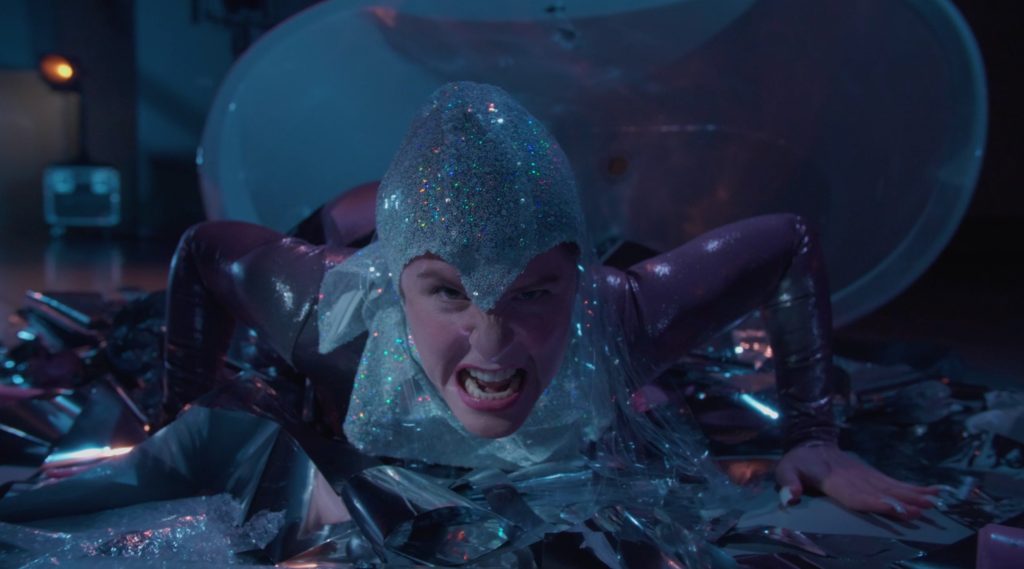Reframing Trash: Alyssa Martin adapts Bin Chicken to the screen for Toronto Dance Theatre - Vancouver Ballet Society
- Home
- Features 2020 - 2023
- Reframing Trash: Alyssa Martin adapts Bin Chicken to the screen for Toronto Dance Theatre

By Jenn Edwards
When the coronavirus pandemic hit North America in March, Bin Chicken, Alyssa Martin’s first commission for Toronto Dance Theatre, was fully choreographed and about to go into technical rehearsals. After the disappointing cancellation of its premiere, and a six-month hiatus while the building was closed, Martin is back in the studio with the original eight-member cast, reimagining the work as a film to premiere online November 12 via the company’s Youtube channel.
“Film is an interesting way to reinvigorate the creative process,” says Martin. “It brings a new challenge into the mix.” Much of the original piece places dancers in close proximity, so a new stage version would have to be adjusted for social distancing and be performed for reduced audiences, resulting in “a sad, 25 percent version” of the piece, in Martin’s words.

In late September, when Martin and I spoke over the phone, the film was still in pre-production. The plan was to feature each section of the hour-long work in a continuous shot, giving a semblance of the live performance feel, and allowing the dancers the opportunity to show their chops without excessive cutaways. But the cinematography will also acknowledge the strangeness of social distancing protocols that prohibit the original live format. The Winchester Street Theatre will be laid bare for the camera, with the lights and backstage space visible, and perhaps even Martin herself. She describes the film version as a “psychological thriller of what the dancers are going through, trying to perform the work for nobody.”
Known for colourful and absurd works that straddle theatre and dance, Martin usually collaborates with the close-knit ensemble that comprises her own company, Rock Bottom Movement. A prolific, rapid-fire choreographer, Martin founded the company in 2012 while still finishing up a dance degree at Ryerson University. She seized on every opportunity to show her early work, including busking her pieces in the streets of Toronto.
Much of Martin’s body of work pulls from pop culture. Her 2016 MANICPIXIEDREAMGIRLS was inspired by the romantic comedy film, Garden State. In 2017, Dolphin centred around the TV teen drama Gossip Girl, and for a section of fantasylover, she repurposed Tessa Virtue and Scott Moir’s entire 2018 Olympic gold medal ice-dance routine for two female performers in socks. While drawing inspiration from teen dramas and ice skating could be viewed as bold moves for a contemporary choreographer, Martin admits to feeling like she sometimes hides behind these popular references.
Recently she has started creating from a more personal place, and it is paying off. Last year’s Hollow Mountain earned two Dora Mavor Moore awards for outstanding production and for outstanding performance by an ensemble. The creative process was her longest ever, spanning 14 months and residencies at the Banff Centre and Canadian Stage, among others. She used stream-of-consciousness journalling and improvisation as a jumping off point to explore the darkest parts of the performers’ psyches. The piece is a gory, surreal journey, featuring demonic possession, mimed self-mutilation, bizarre songs and tap dancing.

For Bin Chicken, Martin continued exploring the less desirable sides of human existence. On a trip to Australia, upon first seeing an Australian white ibis, she admired the bird’s beauty and majesty. However, through conversations with locals, she soon realized that the birds are colloquially called bin chickens, that they live on people’s trash and are thought of as vermin.
Back in Canada, she pitched a piece to TDT’s now former artistic director, Christopher House, that would use the bin chicken to represent the parts of ourselves we are not so proud of, or in Martin’s words, “our inner trash.” She also used the concept as a way of coping with her own feelings of intimidation around choreographing on TDT, a prestigious modern dance company with a long history, for the first time. “I felt like I was a little bin chicken at the institution.”
Rehearsal videos taken in March show that in defiance of the white ibis’ trash-raiding reputation, Martin’s birds give off a palatial vibe, prancing proudly in sparkly bodysuits to a Beethoven sonata, played live on a grand piano. Bin Chicken feels like a Merce Cunningham piece punctuated by squawking, nonsensical monologues, and contorted solos and duos. Despite its quirky veneer, the humanity of the performers shines through.

One element that makes Martin’s work stand out is the use of highly technical movement vocabulary inside pieces that are funny, shocking and messy. She pokes fun at dance conventions while also revelling in them, keeping the joy of dance at the forefront. Another trademark is building fantasy worlds around the performers, allowing them to escape their everyday realities and become bolder, more saturated versions of themselves. As part of the process for Bin Chicken, each dancer developed their own unique bird persona, backstory and journey through the work.
Accessibility, escapism and a sense of play are pillars of Alyssa Martin’s dance-making. She takes the perspectives of her collaborators into close consideration with everything she makes, and Bin Chicken is no exception. In Martin’s own words, “I keep working on making better playgrounds.”

